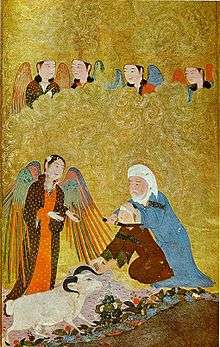Timurid Renaissance
Timurid Renaissance was a historical phenomenon of the rise of arts and sciences in the Timurid Empire that occurred during the reign of Timurid dynasty in the period between the late 14th and early 16th centuries.[1] The use of term of renaissance for the description of this period has raised reservations among scholars and some of them see it as a swan song of Timurid culture.[1][2] It was flourishing at the same historical epoch when Europe experienced Renaissance movement. Timurid Renaissance reached its peak in the 15th century after the end of period of Mongol invasions and conquests. One of the symbols of the Timurid Renaissance is the rebuilding of the Samarkand by Timur. Samarkand, important Islamic center for scholarly study, was destroyed by Genghis Khan during the Mongol conquest of Khwarezmia. Timur reign experienced revived interest in the classical Persian art. Large-scale building projects have been undertaken (mausoleums, madrasas, and kitabhane-medieval Islamic book workshops), mathematics and astronomy got more attention, and at the beginning of the 16th century mastering firearms was achieved. Major commissions from the Timur’s lifetime were the Timur's Summer Palace in Shahrisabz, Bibi-Khanym Mosque, as well as reconstruction of the city of Samarkand itself.[3] The city of Herat became important center of intellectual and artistic life in the Islamic world during this time.[3] The fact that Samarkand and Herat were able to become the centers of Timurid Renaissance and Persian culture at that time in general is due to the destruction of Persian cities by previous wars.[4] Timurid Renaissance differed from the previous cultural and artistic developments during the Buyid dynasty in fact that it was not direct revival of classical models but it rather broaden the cultural appeal by including more colloquial style in Persian language as well as by including more widespread Turkic language as a literary and the official language.[2]
See also
References
- 1 2 Subtelny, Maria Eva (November 1988). "Socioeconomic Bases of Cultural Patronage under the Later Timurids". International Journal of Middle East Studies. 20 (4): 479–505. Retrieved November 7, 2016.
- 1 2 "A Companion to the Worlds of the Renaissance, Guido Ruggiero". Archived from the original on November 8, 2016. Retrieved November 7, 2016.
- 1 2 "The Art of the Timurid Period (ca. 1370–1507)". Archived from the original on November 25, 2016. Retrieved November 7, 2016.
- ↑ "Timurids". Archived from the original on November 8, 2016. Retrieved November 7, 2016.
